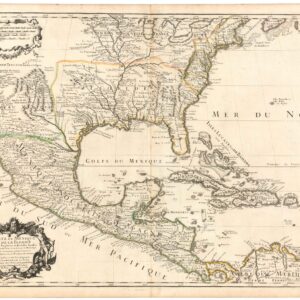First map to name the United States and a contemporaneous illustration of the American Revolutionary War.
Carte du Théatre de la Guerre actuel entre les Anglais et les Trieze Colonies Unies de l’Amerique Septentrionale dressée par J. B. Eliot Ingénieurs des Etats Unis 1778.
Out of stock
Description
The First Map to Use the Name “United States”
This map, the first to use the name “United States” to refer to the newly independent United States of America, was published in Paris in 1778. France, one of Europe’s rich and powerful colonial empires with a strong tradition of arts and sciences, had been a center of European cartography since the middle of the 17th century when Louis XIII and Louis XIV sponsored the work of Nicolas Sanson. The great era of French map making was characterized by a transition from the highly decorative and artistic approach of earlier European maps, such as those of Italian, Spanish, and Dutch, to a more scientific effort that would characterize maps in the 19th century. This beautifully executed map is a product of that tradition, published in 1778 by Parisian cartographer Louis-Joseph Mondhare.
The July 4, 1776 Declaration of Independence claimed the rights of the “thirteen united States of America” (capitalization as in original), but for some time after, the phrases “United Colonies” and “United States” were both used, as can be seen in this extremely rare historical artifact, Les Treize Colonies Unies de l’Amerique Septentrionale (The Thirteen United Colonies of Northern America). Indeed, the map’s title refers to the “colonies,” but, with the map’s credit to “J. B. Éliot, Ingéineurs des Etats Unis,” it is the first map to use the name “United States.”
Only thirteen years before this map was produced, France had suffered a stinging defeat in the Seven Years’ War (which included America’s French and Indian War) and had ceded their claim to Canada to their long-time rival, England. France was therefore happy to support the states’ revolution against the British crown. By late 1777, France had recognized the new nation, and was providing aid by 1778. This map is a product of that larger French assistance and interest in American affairs. With its inclusion of Valley Forge, and indications of the lines of march of the American Revolutionary forces during their 1777 campaigns, it shows a near-contemporaneous view of the war.
Valley Forge
This map notes the town of Valley Forge, Pennsylvania (misspelled “Walay Forge”), where the American Revolutionary forces famously camped during the winter of 1777-1778 after their defeat at Philadelphia, less than 20 miles to the south. Valley Forge was notable only as the encampment of the Revolutionary Army, so its inclusion on this 1778 map shows very timely knowledge of the developments in America. In this, the first edition, the name is misspelled (“Walay Forge”), and the name’s insertion as an angled curve (in contrast to most town names, which are listed horizontally), suggests that it was a relatively late insertion into the engraving.
Who Was J. B. Eliot?
This map identifies its maker as “J. B. Éliot, Ingéineurs des Etats Unis.” In the second edition Éliot is identified as an “aide-de-campe” to General Washington, but attempts to identify this individual have proven difficult. There is no record of anyone of this name serving under Washington. The French accent aigu in the name “Éliot” suggests French roots. The map historian Walter Ristow speculated that Eliot was a liaison between General Washington and France, but further research in the Bibliotheque Nationale de France has found no record of any military officer of this name serving in any capacity in the Depo des Cartes et Plans (the cartography department). Éliot may have simply been a French draftsman attempting to augment the commercial viability of his map by claiming association with the new nation–it would not be the first time this happened in the history of cartography, or maybe he was an actual aide-de-camp using a pen name.
Publication History and Census
This important map exists in two known states. The first edition, as here, can be identified by the date, 1778, and the misspelling of Valley Forge, as ‘Walay Forge.’ A second edition was issued in 1781 with these errors corrected.
This map is extremely rare. An example appeared in a 1998 Sotheby’s London auction, where it was described as one of only 6 known examples. Our research has identified at least[ cut the “At least”?] 9: three at the Library of Congress, four in American academic collections, and only two (including the present example) in private hands. It is an item of extreme rarity and great historical significance – a once in a lifetime piece for the discerning Americana collector. Offered together with Geographic Rare Antique Maps.
Cartographer(s):
Louis-Joseph Mondhare, born in 1734 and died August 21, 1799, was a writer and map publisher from Normandy but working in Paris.
Condition Description
Very good. Original centerfold.
References
OCLC 244678981. Library of Congress, G3710 1778 .E4. Ristow, W., American Maps and Mapmakers: Commercial Cartography in the Nineteenth Century, p. 61-62. Schwartz, S. and Ehrenberg, R., The Mapping of America, plate 122. Pritchard, M., and Taliaferro, H., Degrees of Latitude, #58.






